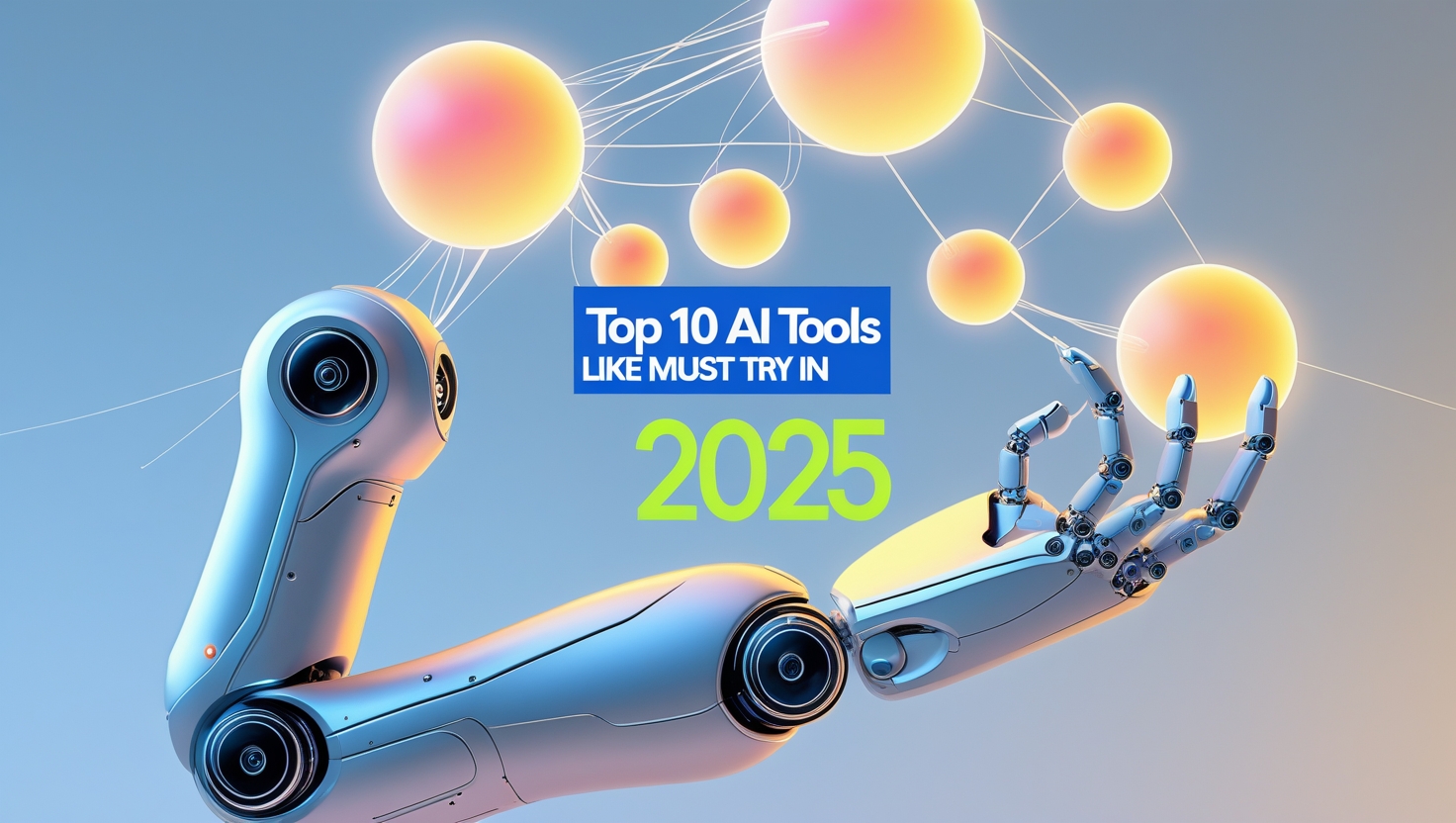AI chatbots like ChatGPT and Google Bard are more popular than ever. ChatGPT alone handled about 37.5 million searches per day in 2024 and has millions of users. But ChatGPT isn’t the only game in town – many new AI tools can chat, write, or create images and videos for you. This article explores ten of the most useful ChatGPT alternatives and complements in 2025. For each tool we explain what it does, why it’s useful, who it’s good for, and whether it’s free or paid. By 2025, AI helpers will keep improving. All the tools below offer free or low-cost versions, so you can try them out. Some focus on conversational chat, while others help you write articles, make artwork, or even create videos. Let’s dive in!
Google Bard (Free Chatbot from Google)
Google Bard is a free AI chatbot from Google (powered by its LaMDA model) that you can talk to for help with questions or tasks. It launched in 2023 and is designed as a “helpful collaborator” for productivity and curiosity. For example, you can ask Bard to help plan a trip, write a quick summary, or explain a topic in simple terms. Bard draws on the internet in real time, so its answers are often up-to-date.
-
Who it’s good for: Students, researchers, or anyone who wants quick, conversational help with questions.
-
Key features: Free to use (for users 18+) connects with Google services (like Gmail and Docs) for richer answers.
-
Free or Paid: Free.
Microsoft Bing Chat (Copilot)
Microsoft’s AI chat tool – now often called Bing Chat or Microsoft Copilot – is a ChatGPT-like assistant built into the Edge browser and Windows. It uses OpenAI’s powerful GPT-4 model for free. To use it, you just sign into Edge and click “Chat.” You can ask Bing Chat to write text, answer questions, or even generate images (using DALL-E) when you switch to Creative mode. It’s a great free option if you have a Microsoft account and use Edge.
Microsoft also integrates similar AI help into its Office apps (Word, Excel, etc.) under the name Copilot. That Copilot adds suggestions and automation (for example, drafting an email or analyzing data in Excel) directly in those apps. However, Office Copilot is only available to Microsoft 365 subscribers (~$20/month).
-
Who it’s good for: Anyone on Windows or Edge who wants a free GPT-4 chatbot. Also useful in Office apps if you subscribe to Microsoft 365.
-
Key features: Free GPT-4 chat, web-grounded answers (founded on Bing search). Three conversation modes (Creative, Balanced, Precise) help it adapt tone.
-
Free or Paid: Bing Chat is free. (Office Copilot features require paid subscription.)
Anthropic Claude AI (Free & Pro Chatbot)
Claude is an AI assistant built by Anthropic, a company focused on making AI safe and friendly. Claude is trained to be helpful, honest, and harmless, so it often produces thoughtful, creative responses. It can chat about many topics, summarize text, answer questions, or even write and edit content for you. People report Claude feels conversational and creative, and it lets you steer it by specifying tone or style.
-
Who it’s good for: Users who want a safe, conversational AI for writing, coding, or learning. It’s often praised for friendly style and fewer mistakes.
-
Key features: Claude can handle text and even images (analysis and generation). It’s good at creative writing and data tasks. Anthropic offers two versions – the regular Claude and a faster Claude Instant.
-
Free or Paid: There is a free tier that lets you chat and create content (with some usage limits). A Pro plan (~$20–$25/month per user) gives you more usage, web search, and other advanced features.
Writesonic (Free & Paid Writing and Chat)
Writesonic is another AI writing platform. It helps you create SEO-friendly articles, ads, landing pages, and more. It includes an AI chatbot called Chatsonic (covered next), and tools for rewriting or expanding text. Writesonic can help with blog posts, ad copy, product descriptions, email drafts, and even auto-generating SEO tags and headlines.
-
Who it’s good for: Solo writers, small businesses, and marketers who want to generate marketing copy quickly. Also helpful for brainstorming ideas.
-
Key features: Article/blog writer, content rephraser, sentence expander, ad copy tools, etc. It also offers an AI chat interface (Chatsonic) for conversation-style use.
-
Free or Paid: Writesonic has a free trial (with limited credits) and a Basic plan from about $16/month (annual billing) up to higher tiers. For example, their Individual plan is $16/month (annual) and a Standard plan is $79/month (annual).
Chatsonic (AI Chat + Marketing)
Chatsonic, by the makers of Writesonic, is an AI chat assistant geared toward marketing and SEO. It’s like ChatGPT with extra marketing smarts. Chatsonic can connect to live internet data (like current news) and integrates with marketing tools (e.g. SEO research) to help you create marketing content. For instance, it can generate blog outlines, social posts, or even draft and publish content to a blog platform.
-
Who it’s good for: Marketing teams, SEO specialists, and entrepreneurs who want an AI that can handle both creative writing and marketing research. It’s built to automate parts of the content workflow.
-
Key features: Combines multiple AI models (like GPT-4 and Claude) and tools (Ahrefs, WordPress) in one chat interface. It has an “AI Marketing Agent” that can execute tasks (research, writing, posting) via conversation.
-
Free or Paid: Chatsonic offers a free trial (you get about 25 free queries when you sign up) and paid plans starting around $16/month (annually).
OpenAI DALL·E 3 (Free Image Generator)
DALL·E 3 is OpenAI’s state-of-the-art image generator. Like ChatGPT but for pictures, you type in a description and DALL·E 3 draws an image to match. It produces high-quality, detailed artwork and is better than previous versions at following your prompt precisely. In fact, DALL·E 3 is built to work together with ChatGPT (you can refine your prompts in chat and then send them to DALL·E). OpenAI has released a free public version of DALL·E 3, so anyone can try it without cost.
-
Who it’s good for: Creatives, students, or anyone who needs custom images. Use it for making illustrations, concept art, or just fun pictures.
-
Key features: Advanced text-to-image with high detail. Strong understanding of nuance in descriptions. It also has safety filters (no hateful or illegal content).
-
Free or Paid: Free: OpenAI provides a free version of DALL·E 3 for public use (with some usage limits). It’s also included with ChatGPT Plus in the ChatGPT interface.
Midjourney (Paid Image Generator via Discord)
Midjourney is another leading AI image creator. It runs through Discord (or a web app) and quickly turns your text prompts into artistic images. It’s known for its creative, high-quality art and is especially loved by designers and artists. You type a description in Discord, and Midjourney generates several image options to choose from. It also has features to upscale images, make variations, or blend styles.
-
Who it’s good for: Anyone wanting artistic or professional-looking images. Great for graphic designers, game developers, or marketers who need visuals but can’t hire a designer for every job.
-
Key features: Instantly generates four unique images per prompt. Supports advanced refinements (upscaling, variations). Allows custom commands to maintain style consistency.
-
Free or Paid: Paid: Midjourney offers subscription plans. The basic plan starts at around $10/month. (It used to have a short free trial, but now a subscription is needed.) Plans go higher for more image generations per month.
Synthesia (Free & Paid AI Video Creator)
Synthesia is an AI video creation tool. Instead of filming a person, you type a script, and Synthesia produces a video of a realistic digital avatar speaking your words. You can choose from many avatar characters and languages. It’s useful for making training videos, presentations, or announcements without cameras or actors. For example, a teacher could make a lecture video by simply entering text and picking an avatar.
-
Who it’s good for: Educators, businesses, and content creators who need quick videos (like tutorials or ads) but don’t want to film themselves.
-
Key features: Over 140 supported languages; lots of AI avatars; script-to-video and text-to-video. An AI voice reads your text naturally. It even has features like auto-translating videos.
-
Free or Paid: Synthesia has a free plan that includes 3 minutes of video per month and access to 9 avatars. The paid plans start around $29/month for more minutes (10 minutes/month on the Starter plan) and more avatars.
Notion AI (Paid Productivity Assistant)
Notion AI is an add-on to the popular Notion workspace app. Notion is like a digital notebook and wiki for teams. Notion AI brings GPT-4 (and Anthropic’s Claude) into your workspace to help write, summarize, and brainstorm right inside your notes. For example, you can ask Notion AI to draft a meeting summary, create to-do lists, or rephrase a sentence. It can also pull data from apps like Google Drive or Slack (in beta) to enrich answers.
-
Who it’s good for: Teams and individuals already using Notion. It helps with note-taking, planning, and writing tasks in one place. Students, writers, and project managers find it handy for quick drafts and ideas.
-
Key features: Summarize pages, generate text in any document, chat with AI (GPT-4/Claude), and auto-fill databases with insights. It connects to your own documents for context.
-
Free or Paid: Paid add-on: Notion AI costs about $8 per person per month (billed annually) or $10 (monthly). There is a free trial so you can test it. You must be on a Notion plan (even the free plan) to add it.
Conclusion
By 2025, AI tools will only get smarter and more common. The ten tools above show how many ways you can get AI help beyond ChatGPT. Some are pure chatbots (like Bard and Claude), while others specialize in writing, images, or video. The great news is that most offer free tiers or low-cost plans, so anyone can experiment. Try a few and see what you like! These AI assistants can save time, spark creativity, and even handle routine tasks. The future of AI-powered work and play is exciting, and with these tools you have plenty of new helpers to try out in 2025.
FAQ
Q: Are these AI tools really free to use?
A: Many have free versions. For example, Google Bard and Microsoft’s Bing Chat are free to use (with an email or Microsoft account). ChatGPT itself is free too. Tools like DALL·E 3 and Synthesia offer limited free usage (DALL·E 3 has a public free tier, and Synthesia’s free plan gives 3 minutes of video). Others require payment beyond a trial – for example, Jasper or Notion AI cost around $10–$40 per month for full features.
Q: How do I choose which tool to use?
A: Think about your goal. If you want to chat and ask questions, try Bard, Bing Chat, or Claude. For writing help (articles, emails, ads), Jasper or Writesonic/Chatsonic are top choices. For images, try DALL·E 3 or Midjourney. For making quick videos with talking avatars, Synthesia is ideal. Notion AI is best if you already use Notion for notes. Many tools have free trials, so experiment to find which style and features you prefer.
Q: Are these AI tools safe and accurate?
A: These tools are generally designed for helpfulness and safety. For example, Claude was trained to avoid harmful content, and DALL·E 3 blocks hateful or illicit images. However, AI can make mistakes or “hallucinate” (give incorrect answers). Always double-check important information. It’s also wise to avoid sharing sensitive personal data. Read each tool’s safety or privacy notes before using.
Q: Will these tools replace humans?
A: No, they are tools to help humans. They can draft text or generate images quickly, but often need a human to review and edit. They save time on repetitive tasks and can spark ideas, but creative judgment, humor, and deep expertise still come from people. Think of these AI helpers as a second brain or assistant – they work best when you guide them with clear instructions and then refine their output.
Q: Can I use multiple tools together?
A: Absolutely. You might use Bard to brainstorm topics, then Jasper to expand an outline into a blog post, and DALL·E to create accompanying images. Many users switch between tools depending on the task. Some tools even integrate with each other (for example, Notion AI can use GPT-4 or Claude as its engine). The AI landscape in 2025 is very flexible, so mix and match tools to fit your project.









